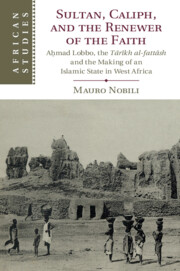 Sultan, Caliph, and the Renewer of the Faith
Sultan, Caliph, and the Renewer of the Faith from Part I - A Nineteenth-Century Chronicle in Support of the Caliphate of Ḥamdallāhi: Nūḥ b. al-Ṭāhir’s Tārīkh al-fattāsh
Published online by Cambridge University Press: 28 February 2020
This chapter presents the reader with the Tārīkh al-fattāsh, an indispensable source for understanding the Middle Niger in the nineteenth century. It first introduces its author, Nūḥ b. al-Ṭāhir, and his writings. Then, it exposes Nuḥ b. al-Ṭāhir’s skillfulness in embedding new pieces of writing into an older chronicle, the seventeenth-century “Chronicle of Ibn al-Mukhtār,” to produce a masterful work in support of his patron, Aḥmad Lobbo. The latter is portrayed as sultan, the authoritative ruler of West Africa and the last of a long line of legitimate rulers modelled on Askiyà Muḥammad, the foremost Askiyà emperor of the Songhay; as the twelfth of the caliphs under whom the Islamic community would thrive, according to a ḥadīth ascribed to the Prophet; and as “renewer” of Islam, who, according to another Prophetic tradition, is sent every one hundred years by God to prevent the Muslim community from going astray.
To save this book to your Kindle, first ensure no-reply@cambridge.org is added to your Approved Personal Document E-mail List under your Personal Document Settings on the Manage Your Content and Devices page of your Amazon account. Then enter the ‘name’ part of your Kindle email address below. Find out more about saving to your Kindle.
Note you can select to save to either the @free.kindle.com or @kindle.com variations. ‘@free.kindle.com’ emails are free but can only be saved to your device when it is connected to wi-fi. ‘@kindle.com’ emails can be delivered even when you are not connected to wi-fi, but note that service fees apply.
Find out more about the Kindle Personal Document Service.
To save content items to your account, please confirm that you agree to abide by our usage policies. If this is the first time you use this feature, you will be asked to authorise Cambridge Core to connect with your account. Find out more about saving content to Dropbox.
To save content items to your account, please confirm that you agree to abide by our usage policies. If this is the first time you use this feature, you will be asked to authorise Cambridge Core to connect with your account. Find out more about saving content to Google Drive.